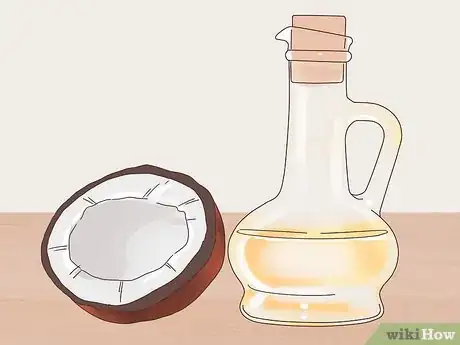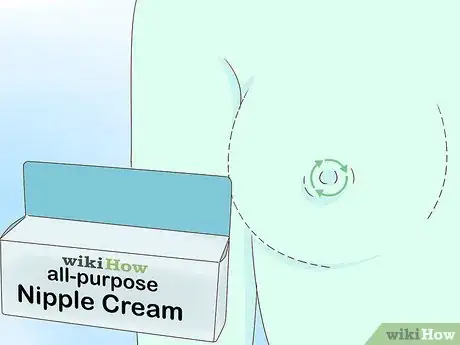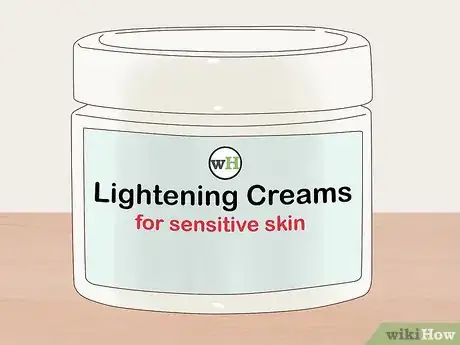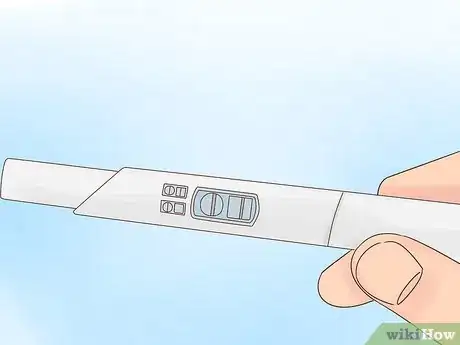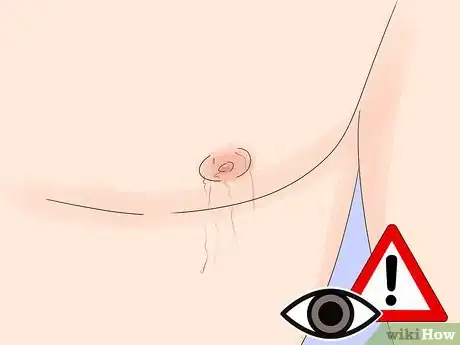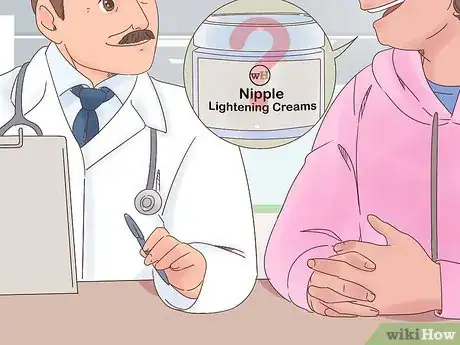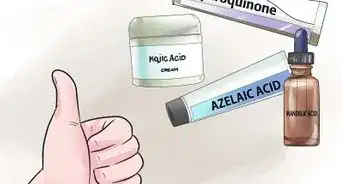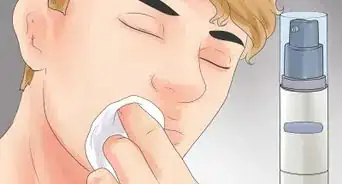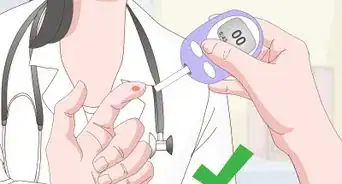This article was co-authored by Kaveri Karhade, MD. Dr. Kaveri Karhade is a board certified Laser, Medical, and Cosmetic Dermatologist in the San Francisco Bay Area. Her areas of expertise are acne and hair loss. She has advanced training in injectables, lasers, surgery, and other cosmetic treatments, and has published extensive research in medical journals. She holds a BS from Michigan State University and a Doctor of Medicine (MD) from the University of Michigan Medical School. She completed her internship in Internal Medicine at New York University School of Medicine and her Residency in Dermatology at Brown University School of Medicine. Dr. Karhade is a fellow of the American Academy of Dermatology and a member of the American Society for Dermatologic Surgery.
There are 8 references cited in this article, which can be found at the bottom of the page.
This article has been viewed 313,379 times.
Most men and women have nipples that are darker than their skin tone. However, the color of your nipples can change throughout your lifetime. While these methods aren't scientifically proven, if you want your nipples to be lighter, you can use oils, like coconut oil, and nipple creams to try to lighten them. Keep in mind that having dark nipples is completely normal, and you shouldn’t feel ashamed of your body.
Steps
Using Oils and Creams
-
1Use coconut oil to naturally lighten the nipple and add moisture. Coconut oil is commonly used to make skin brighter and lighter, and it’s safe for use on most skin types. Apply about 1 teaspoon (4.9 mL) of coconut oil to each nipple, and let it soak into the skin.[1]
- It may take anywhere from 1-2 months to see results using this method. Be patient and apply the oil every day.
- This is one of the least expensive treatments for dark nipples, and it helps to add moisture to the nipple and areola.
-
2Apply an all-purpose nipple cream to treat dryness. Sometimes, dry skin can cause the skin on your nipple and areola to darken. Purchase an all-purpose nipple cream, which is normally used for breastfeeding, and apply it to your nipples according to the package directions. Continue applying the cream regularly to prevent dryness.[2]
- If you’re currently breastfeeding, consult with your doctor to find a nipple cream that will work best for your needs.
Advertisement -
3Consider using a commercial lightening cream for quick results. Most lightening creams on the market are safe for short-term cosmetic use. Look for a product that is specifically formulated for sensitive skin to prevent rashes or inflammation.[3]
- If you experience tingling, itching, or redness after applying the cream, rinse the area with water thoroughly.
- Do not use lightening creams for longer than 6 weeks at a time. Prolonged use can lead to a buildup of harmful chemicals in your body.
-
4Avoid products that contain harmful bleaching ingredients. If you find a product that contains mercury-based ingredients or a more than 2% concentration of an ingredient called hydroquinone, do not use the product. These ingredients have been linked to harmful side effects, such as cancer.[4]
- Be sure to check the ingredients list carefully before using any product.
- Never purchase products that are not approved for use in your country. This is dangerous and may possibly be illegal, depending on the item.
Identifying the Causes of Dark Nipples
-
1Understand that your nipples can get darker during puberty. Many women experience nipple darkening for the first time during puberty, which occurs when girls are around 8-9 years old. Don’t be concerned if your nipple becomes darker or larger when you’re going through puberty. It’s completely normal and caused by hormonal changes in your body.[5]
- Nipples come in many different shapes, sizes, and colors. Try not to be ashamed of your body or worried about how other people may view it.
-
2Take a pregnancy test if there’s a chance you may be pregnant. It’s common for your nipples to become darker during the early stages of pregnancy. If you might be pregnant, purchase and take a test to quickly diagnose the cause of your dark nipples.[6]
- For the most accurate results, take the test in the morning of the first day of your expected period.
-
3Consider that your nipples might darken naturally with age. Due to the hormonal changes that happen as you get older, your nipples might change color. If you’re going through menopause or are taking a medication that contains hormones like progesterone or estrogen, expect your nipples to become slightly darker.[7]
- Remember to get regular mammograms and perform monthly breast examinations on yourself so that you can notice any unusual changes to your breasts.
-
4Inspect your nipples to see if they have small hairs on them. Often, people mistake the presence of small hairs for discoloration. Look closely at your nipples and areola closely to identify small, dark hairs, which grow from follicles on the nipple. These hairs are normal and shouldn’t be a cause for concern.[8]
- Avoid plucking or shaving this, which can cause painful ingrown hairs. If you want to remove these hairs, carefully trim them with a small pair of scissors.
Consulting a Doctor
-
1Ask your doctor to prescribe a safe cosmetic nipple lightening cream. If you’ve tried multiple methods for lightening your nipples with no success, visit your doctor to discuss your concerns. They may be able to prescribe a medicated ointment that is safe for short-term use.[9]
- These might include creams like hydroquinone, azelaic acid, and kojic acid. Keep in mind that these should only be used under the direction of your dermatologist.[10]
- Be sure to tell your doctor about any treatments that you’ve tried.
- While having dark nipples is perfectly normal, don’t be afraid to talk to your doctor about cosmetic treatments for lightening your nipples if it’s something that is important to your self-image.
-
2Tell your doctor if your nipples don’t lighten after pregnancy or breastfeeding. Your nipples should lighten to their original shade around 2-3 months after you give birth or stop breastfeeding. If they don’t, make an appointment to see your OB/GYN, where they may be able to diagnose any underlying causes for the darkness.[11]
- In many cases, darker nipples after pregnancy and breastfeeding are due to a hormonal imbalance that can be easily treated.
- Keep in mind that changes in nipple size and shape during pregnancy are normal and can’t be reversed without cosmetic surgery.
-
3Visit your doctor immediately if you experience nipple itching or discharge. While rare, changes in nipple color along with other symptoms can be a sign of certain types of cancer, such as Paget Disease of the Breast. If your nipple is frequently itchy or dry, or you notice a white or yellow discharge from your nipple, make an appointment immediately or visit the emergency room for treatment.[12]
- A doctor will be able to take a sample of your breast tissue to check for cancer or other diseases.
Warnings
- Never use a product that burns your skin or causes a rash. If you experience tingling or burning when you apply a product, rinse your nipple immediately and do not use the product again.⧼thumbs_response⧽
References
- ↑ https://breastfeeding.support/treatments-sore-nipples/
- ↑ https://breastfeeding.support/treatments-sore-nipples/
- ↑ https://www.nytimes.com/2006/05/14/world/asia/14thailand.html
- ↑ https://www.nytimes.com/2006/05/14/world/asia/14thailand.html
- ↑ http://www.healthywomen.org/content/ask-expert/1296/normal-breast-changes-over-lifetime
- ↑ http://americanpregnancy.org/pregnancy-health/breast-changes-during-pregnancy/
- ↑ http://www.healthywomen.org/content/ask-expert/1296/normal-breast-changes-over-lifetime
- ↑ https://www.unitypoint.org/livewell/article.aspx?id=14dcbcf6-6ab3-43eb-a112-7adacec8ecf1
- ↑ https://www.ncbi.nlm.nih.gov/pubmed/12472496
- ↑ Kaveri Karhade, MD. Board Certified Dermatologist. Expert Interview. 5 January 2021.
- ↑ https://www.unitypoint.org/livewell/article.aspx?id=14dcbcf6-6ab3-43eb-a112-7adacec8ecf1
- ↑ https://www.cancer.gov/types/breast/paget-breast-fact-sheet
About This Article
If you want to lighten your nipples, apply 1 teaspoon of coconut oil to each nipple and let it soak into the skin. Repeat this process daily to keep your nipples healthy and moisturized. Alternatively, try using a commercial lightening cream to lighten your nipples. Just make sure to stop using the product if you experience tingling, itching, or redness on your skin, since you may be allergic to it. To learn how to get a prescription lightening cream for your nipples, read on!
